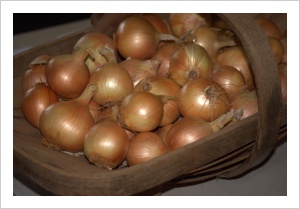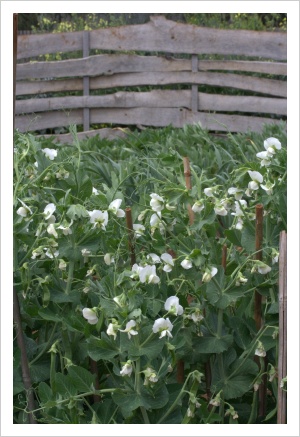Planting time for onions and peas
I’ve taken advantage of a lull in the cold wet weather that we’ve been having in Victoria to get some seed sowing done. I’ve sown onion and pea seed this week as well as getting my garlic in. I usually plant garlic around the shortest day but this year it was too wet to plant until this week.
There can hardly be a better onion for gardeners than ‘Pukehohe Long Keeper’ (‘P.L.K.’) as it will store in good condition for nine months.
 From an August 2013 planting we’ve had top quality onions since January. Just about all of last year’s crop had thin necks and these are the best for keeping. Bulbs with thick necks don’t keep and are used first.
From an August 2013 planting we’ve had top quality onions since January. Just about all of last year’s crop had thin necks and these are the best for keeping. Bulbs with thick necks don’t keep and are used first.
‘P.L.K.’ is an intermediate day length strain and should only be sown in areas south of central NSW as it needs 13-14 hours of daylight to bulb up.
Seed can be sown from early July until early August. Much better results will be got if seed is sown directly into the onion’s final spot rather than planting in seed trays or seed beds for transplanting later. Sow seed in a 10cm wide drill and thin to 5 or 6cm apart. Thinnings can be used as scallions.
Red onions generally don’t store well and it’s a mystery to me how greengrocers can have them the year round. ‘Red Shine’ is a fairly new variety which does have good storing capabilities but even so three or four months would be its keeping limit. ‘Red Shine’ is an intermediate variety.
Vegetable breeders have been working on white onions and some of the new hybrid strains are a great improvement on older varieties. ‘Callisto F1’ has good looks, a gentle flavour and excellent storage potential. It is generally thin necked. An intermediate onion it can only be planted south of central NSW.
Harvest onion bulbs when 70 to 80% of their tops are down, that is when the tops lie along the soil rather than sitting straight up. I lift the bulbs then and take them straight to a shed where they are allowed to dry for a month or so. It’s important to allow some airflow around the bulbs so that they don’t go mouldy. When they are cured I clean them up and put them into my large walk in pantry which stays 14-16 centigrade throughout the winter. I store them on a single layer in bulb crates which allows for good air circulation.
Peas
 At long last there are some excellent new pea varieties available to home gardeners. The dwarf shelling pea ‘Super Gem’ has the largest pods of any dwarf variety, up to 13cm long and with eleven peas to each pod. It is a great variety for the show bench as well as being a succulent variety for the kitchen or best of all eaten freshly picked in the garden. As it has high resistance to powdery mildew it can be planted as late as November in southern parts of Australia.
At long last there are some excellent new pea varieties available to home gardeners. The dwarf shelling pea ‘Super Gem’ has the largest pods of any dwarf variety, up to 13cm long and with eleven peas to each pod. It is a great variety for the show bench as well as being a succulent variety for the kitchen or best of all eaten freshly picked in the garden. As it has high resistance to powdery mildew it can be planted as late as November in southern parts of Australia.
I grew the dwarf snow pea ‘Green Devil’ last year and it was so prolific that even though I only planted a metre or so I could hardly keep up with the picking. The dark green pods, straighter than older varieties, are produced under a variety of weather conditions. As it is resistant to powdery mildew it can be planted well into spring.
Sugar snap pea ‘Sugar Bon’ also has good resistance to powdery mildew and can be planted right through the pea season. It is a dwarf variety and is popular with both professional growers and home gardeners.
Even though these varieties of pea are dwarf growers they still need some support. When the pea plants are 15cm or so tall I stick in old canes and elm twigs on each side of the row at an angle so that they cross each other. The peas will twine around these sticks and keep their pods off the ground. It makes picking easier and looks tidier.